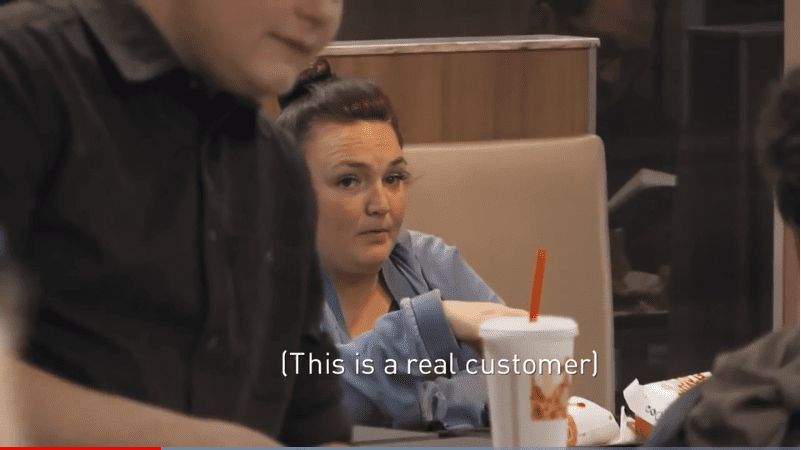Bullying Prevention: How to Talk So Teens Will Listen
I wanted to talk to my students about bullying in a new way, so I started with this PSA from Burger King. I know. I was surprised besides.
The public service ad was produced past Burger King with the assistance of NoBully.org in 2017, and information technology's a swell instruction tool. The emotional three-infinitesimal video shows real customers in a Burger King watching on as a high school junior is bullied.
Meanwhile, an employee is "bullying" Whopper Jr. sandwiches—insulting the burgers, hitting them, damaging them. Customers quickly complain. "Had you seen me bullying this burger, would you have stood up and said something?" the cashier asks.
You can watch the video here:
[embedyt] https://www.youtube.com/scout?v=mnKPEsbTo9s[/embedyt]
Sure, it's a bit giddy.
The connexion between bullying and a wrecked burger might be a fleck of a reach, but the video does something incredibly powerful. It aims its lens not at the young people engaging in the bullying but at the adults who are bystanders. These adults, by and large, are doing admittedly nothing to stop information technology.

As a teacher, this struck me as profoundly sad.
After all, aren't we the ones who tell our students, "If you lot're being bullied, tell an adult! They'll help you lot!"
Well, apparently we aren't providing accurate information. Co-ordinate to the PSA, just 12 percent of the adults watching the immature human in the video get bullied by several other boys actually stood up and helped the male child. Not exactly a reassuring statistic for the more than than 30 percent of young people who report being bullied each yr in our country (as well as the endless others who don't report their bullies because they don't believe it will help).
With all this in mind, I thought virtually how I might employ this video with my high school students. Bullying is a significant problem in secondary grades, but talking about bullying with teenagers can be tricky. They've heard all the terms and reasons and mantras earlier. They've signed the pledges. They've engaged in the conversations. In brusque, they're a bit jaded about the topic.
The video is a perfect "in" for a conversation about being an advocate instead of a bystander.
The bystanders in the video weren't teens like my students; rather, the bystanders were adults. Aren't they supposed to know better? What a perfect way to discuss how hard standing upward for someone else can be and why it is so of import that they pledge to themselves at present, equally young people, to always be the person who stands up for those who are in demand.
Below is a cursory overview of what I did with my freshman students along with their responses. I've likewise fastened links to my resources, if you're interested in trying information technology out in your ain classes.
Accessing Background Knowledge
My ninth graders take been talking nearly bullying since kindergarten. I started by asking them to do a five-minute gratuitous write of everything they knew or what came to heed when I wrote the word "bullying" on the board. We chatted as they wrote, and I noticed that, for the near function, they knew what to say. They had the lingo downward and, truthfully, they sounded a bit bored most it all. (This is exactly what I had expected.)

Watching the Video
Later this exercise, I asked them to lookout man the video and then, without talking to each other, write their responses to at least four of the following prompts:
- What were your original thoughts and impressions of the video?
- What did you think well-nigh the bullies, the bullied teen, and the bystanders in the video?
- Why do y'all recall the bystanders were and so quick to mutter most their "bullied" burger, but not most the bullied teen?
- Did it surprise you how few adults stood up to assist the bullied teen? Why?
- Why exercise y'all remember teens don't get involved when they see ane student harassing another student?
- What are some solutions that might actually work to solve the problem of bullying?
- How do you recall our school might alter if more people looked out for each other?
- Would you be willing to be office of a program to aid end bullying in our schoolhouse? Why?
The questions not only touched on the cardinal problems I wanted my students to reflect on from the video but they tied into our culminating action. And by giving the students the selection of only answering four questions, I differentiated the lesson slightly so my students who struggle with coming up with ideas, who accept a difficult time with timed writing, or who are less motivated could meet with success also.
Discussing and Collaborating

I usually determine groups, but this time I decided to take the groups be completely random. It seemed important to take conversations that involved new ways of thinking and feeling. Each student got a sideslip of paper with their rotation assignment on information technology. When they arrived at their stations, they found a question card, poster paper, and markers.
You tin can save and print the pdf of these question cards to utilize in your own classroom: Encouraging Teens to Stand up upwardly to Bullies with Burger King Discussion Prompts
I set up a five-minute timer and asked the students to share their thoughts virtually the questions at their station. Then, I had them utilize the markers to write their principal takeaways, a-ha moments, questions, or thoughts on the paper. At the next station I encouraged them to exercise the same thing and also respond to the comments left by previous groups.
Reflecting and Moving Frontwards

After the students had time to view each of the questions, we talked well-nigh some of the responses. Not surprisingly, my students expressed anger at the adults who did nil to cease the bullying. "But that'southward what happens," one educatee said angrily. "The same affair happens here. Kids bully each other right in front of some teachers, and [the teachers] practice cipher!" Several students agreed, while others defended teachers by saying how hard it is to catch someone bullying.
This led to our concluding activity, side by side steps. In the following days, I showed my students some examples of what other teens had washed to actually make a difference in their own high schools. I showed them the teen who created an app so no ane in the schoolhouse would accept to eat lunch lonely. Or schools that have successful peer helper groups that encourage students to create or sign up for an extracurricular club whose purpose is to gainsay bullying within the school.
In one case students had researched several options of interest to them, I had them write a researched argument letter to our main, stating what they idea should be done almost bullying in our school. By the time they got to this part, most of my students not only wanted to write the letter they wanted to brand sure our primary read the letterand responded. We invited him to come up speak with us about the issue. He left with several ideas to put into practice in our building. The students felt empowered and proud of their efforts.
All thanks to a video from Burger Rex.
How do you talk to your secondary students about bullying? What has your school institute that works? Let us know in the comments!
palmieriprood1944.blogspot.com
Source: https://www.weareteachers.com/bullying-prevention/
0 Response to "Bullying Prevention: How to Talk So Teens Will Listen"
Post a Comment